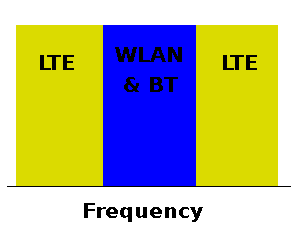The Problem with LTE
In my opinion the architects of LTE have made some mistakes, this isn’t uncommon, many new protocols have had problems in their early days. The system they have created is susceptible to front-end blocking in particular bands.
Consider the band layout:
* LTE band 7 will operate from 2500 MHz to 2690MHz. This is split into an uplink band from 2500MHz to 2570 MHz and a downlink band from 2620 MHz to 2690 MHz.
* LTE band 40 will operate from 2300 MHz to 2400 MHz.
In between these bands is the 2.4GHz ISM band, which runs from ~2.4GHz to ~2.5GHz, the exact frequencies of edges of the band depend on the country. Many systems use this ISM band, WiFi and Bluetooth use it. More obscures systems such as video transmission systems and proprietary wireless keyboard and mice use it.
The diagram below shows the situation:

Yesterday I described the front-end blocking problem in general terms. You don’t have to be an RF genius to understand the problem the LTE architects have created here. The front-end receivers for LTE band 7, LTE band 40, WLAN, Bluetooth are fairly wideband, they will each respond to signals from all of the bands I’ve shown in the diagram.
GSM and WCDMA are “one band at a time” radios. When a GSM radio is using the 900MHz band it doesn’t use the 1800MHz band, or any other band, at the same time. The baseband controllers switches the radio between the various bands, sometimes it does this so fast that it can receive from the 1800MHz band while in call on a 900MHz band. This is achieved by time-division though, the radio never uses both bands at the same time. LTE radios are the same, that means that if a device is transmitting on LTE band 7 then it will not be receiving on LTE band 40. There is little chance of blocking problems within the LTE system.
However, the other radio systems involved, such as Bluetooth and WLAN, are controlled by completely separate baseband controllers. Let’s suppose there is a cellphone that has LTE band 7 and Bluetooth. When the Bluetooth module transmits then that signal will be transmitted from the Bluetooth antenna and received by the LTE antenna from there it will then enter the LTE receiver. Let’s suppose the base-station is transmitting to that same LTE receiver at the time too. As I described in my earlier post on blocking the front-end is unlikely to be able to cope with both of these signals. This will probably result in the LTE information being destroyed. The same applies in the opposite direction, the LTE transmissions can block nearby WLAN and Bluetooth receivers, especially if both are integrated into the same device.
In future posts I’ll discuss what can be done about this.
Tags: Blocking, Bluetooth, Front-Ends, Integration, LTE, Radios, WLAN
